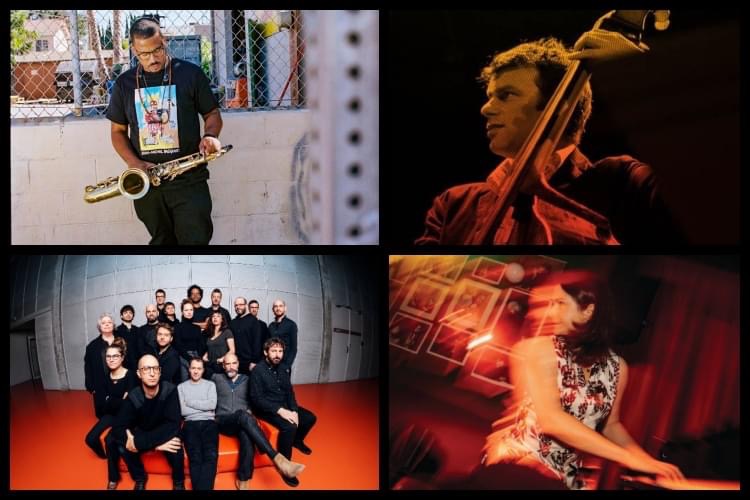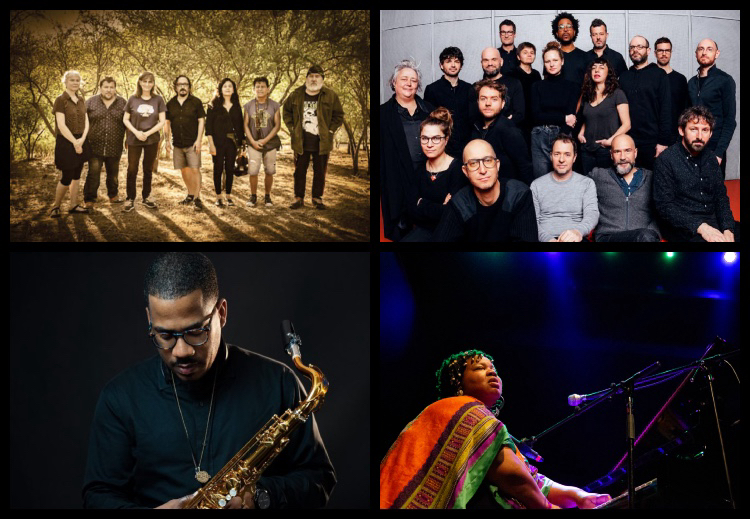PostGenre’s Best of 2022
|
Getting your Trinity Audio player ready...
|
From the mixes of a beat scientist to a double work with a string quartet, our team’s selections for the best albums of 2022 reflect the vibrancy of the contemporary improvised music scene. Some works pull your heartstrings, others are incredibly cerebral, yet others are super funky and make you want to groove. In many cases, chosen albums do all three. In our selections, you can also witness the diversity of methods in which an artist can express themselves, whether by intimate solo performance, communal “musical coding,” or the intense collaboration of a duo. Here are the albums we collectively felt were the best releases of 2022 (or, really, from Thanksgiving 2021 to Thanksgiving 2022 if you want to be a stickler). Ties are ordered alphabetically by the leader’s last name. — Rob Shepherd
10. Makaya McCraven, In These Times (International Anthem/Nonesuch/XL)
Makaya McCraven makes vibes. He always has. It’s almost thematic in his work how much of the atmosphere of what he’s making is part of the work itself. He is a producer of a specific quality of air. While he may have in the midst of so many other projects of the last five years – reworking Gil Scott-Heron, finding new life to live sets – somehow lost focus and intention to make a true follow-up to the landmark 2015 album, In The Moment, he found it yet again in order to create In These Times: a clear statement of where he is and production, in community, in instrumentation, and the atmosphere that he knows how to craft so well. — Anthony Dean-Harris
In These Times is available in our Amazon affiliate store.
8 (tie). Billy Mohler, Anatomy (CONTAGIOUS)
There’s nothing I heard this year that has given me a more visual reaction than Billy Mohler’s Anatomy. What Nate Wood, Chris Speed, and Shane Endsley do alongside Mohler as a quartet is gripping, exciting, and the kind of music that sticks with you for lengthy stretches. It made my list from the moment I first heard it. — Anthony Dean-Harris
Anatomy is available in our Amazon affiliate store.
8 (tie). Jamaaladeen Tacuma & Mary Halvorson, Strings & Things (self-release)
Only barely into her forties, Mary Halvorson has already established herself among the most compelling voices in Twenty-first Century creative music. Often her brightest musical moments come in the smallest of groups, as they reveal her prowess as a spontaneous composer in its starkest light. Stripping away the large collective often exposes her ideas at their rawest and provides a deeper insight into her mind. Her lone solo record thus far, Meltframe (Firehouse 12, 2015), and pairings with Bill Frisell, Sylvie Courvoisier, and John Dieterich all add credence to this perspective. Strings & Things builds upon this to provide her most revealing duo album yet. In no small part, its power comes from her choice of collaborative partner.
Not long ago, Guitar Player stated that Jamaaladeen Tacuma was becoming “regarded as one of the most distinctive forces on bass guitar to emerge in the past decade.” While any recognition of the underappreciated bassist is welcome, they are also several years too late. Since the late 1970s- across his Harmolodic funk work with Ornette, his Grammavision recordings, and the Free Form Funky Freqs- Tacuma has become, arguably, the most consequential bassist since Jaco.
Strings is an entrancing dialogue between two master artists. Neither sacrifice, yet both find common ground. The best moments come when they go completely out in left field, as on “Anesthetic Cloud,” where a deep P-Funkish groove meets plinky and skitterish guitar, or on “Another Day (Night),” where a comforting folkish anthem turns quickly disorienting.— Rob Shepherd
Strings & Things is available on Bandcamp.
7. Cécile McLorin Salvant, Ghost Song (Nonesuch)
If there were a category for the bravest recording of 2022, Cecile McLorin Salvant’s Ghost Song would win in a landslide. An old-fashioned concept album on the nature of grief, desire, attachment, and obsession, Ghost Song is a moonshot that draws on traditional Irish sean-nós singing, Weimar-era agitprop, soothing neo-soul balladry, and Tin-Pan-Alley archaeology. The notion that anyone might sink a shot like this is almost laughable.
Yet she does – behind the back and blindfolded. Ask me tomorrow, and I’m likely to make this my No. 1 recording of the year. Even more astounding than the concept is the degree of attention to detail and craftsmanship that renders each of the twelve selections into museum-quality objects. From the thick, ‘80s bass sound of the album-opening cover of Kate Bush’s “Wuthering Heights” to the tinny cabaret banjo on the Brecht/Weill/Blitzstein “The World Is Mean,” the production decisions at every turn are both spectacularly daring and perfectly brought off.
But Ghost Songs is more than just a collection of covers. The horror-film mad scene of “I Lost My Mind” is one of seven originals on Ghost Song. These originals signal McLorin-Salvant’s increasing maturity and confidence in center-staging her comprehensive and inquisitive compositional voice. The title cut begins as a raw-voiced field holler and ends in a touching chorus of children’s voices. Her “Obligation” is a chatty internal monologue on the perils of modern relationship styles, and she even plays wonderfully Monkish stride piano on the instrumental “Trail Mix.” What can’t this woman do?
The plotting of the songs is as nervy as the music. She follows the charming fluff of Herbert Stothart and Harold Arlen’s “Optimistic Voices” (the vaudevillian number sung as the four heroes approach the Emerald City of Oz in the 1939 film) with a firmly committed yet consolatory reading of Gregory Porter’s ballad “No Love Dying.” It’s a drop that the cleverest DJ might envy.
Through all of these wildly varied settings, McLorin-Salvant’s voice is pure yet warmly expressive. Her diction is crystalline, even at breakneck speed, and she finds the center of each note as though guided by musical GPS.
It’s fair to ask after an achievement of this magnitude where this endlessly curious and extravagantly gifted artist can go next. Here’s an idea: 2022 brought the premieres of high-profile operas co-created by esperanza spalding and Rhiannon Giddens. Ms. McLorin-Salvant, you’ve got next. — John Chacona
Ghost Song is available in our Amazon affiliate store.
5 (tie). Jeff Parker, Forfolks (International Anthem/Nonesuch)
Jeff Parker has that kind of quality and works so consistently that he can conceivably pop up in all kinds of folks’ year-end lists. He’s a brilliant guitarist whose approach to the instrument has a signature sound that always seems to perfectly fit. At the very end of 2021, Parker gave us a solo meditation that could sustain all the next year through. — Anthony Dean-Harris
Forfolks is available in our Amazon affiliate store.
5 (tie). Columbia Icefield [Nate Wooley], Ancient Songs of Burlap Heroes (Pyroclastic)
Trumpeter Nate Wooley is a decorated general in the battle to change the misconception that experimental music is somehow unlistenable. His publication, Sound American, uses words as its weapon of choice to attack the concept that the abandonment of strictures renders music utterly unapproachable. Columbia Icefield’s sophomore release capably uses an arsenal of sounds.
Ancient Songs transports the listener to frozen tundras and ragged desolate shores. Dizzying winds and crashing waves. In the distance, a small crew of voyagers tries to make their way through the rugged terrain. The brave crew’s calls reflect a fight for survival and an enthrallment by the, though vicious, beauty surrounding them. These are things listeners can pick up on and appreciate from the album, partly because of that persevering struggle inherent in the album’s folk roots. Even if the language is a little foreign, a listener can understand Wooley’s intent without fully appreciating the works of Éliane Radigue or Anthony Braxton.
But permitting better audience understanding does not equate to a diminishment of Ancient Songs’ artistic significance. Beneath the surface, meaningful commentary on humanity’s relationship with nature and the interaction between silence and sound emerge. As to the latter, distorted waves dissolve into nothingness on the final interlude, “(……………),” to allow for the power of space to enter the room. At times haunting, melancholic, and triumphant, Ancient Songs is consistently beautiful as much for what it explicitly states as that which it does not.— Rob Shepherd
Check out Rob Shepherd’s two-part interview with Nate Wooley on this album here and here.
Ancient Songs of Burlap Heroes is available on Bandcamp.
4 . Myra Melford’s Fire and Water Quintet, For The Love Of Fire And Water (RogueArt)
Maybe it’s just coincidental that Myra Melford grew up in a house designed by Frank Lloyd Wright, who made harmony with nature a guiding principle of his art. Still, For The Love Of Fire And Water, which was inspired by the collection of drawings that artist Cy Twombly called Gaeta Set (for the Love of Fire & Water), is a recording that combines Wright’s sense of balance and proportion with the quicksilver inspiration of Twombly’s drawings of light and water.
This is no “Pictures At An Exhibition,” though. In Natalie Weiner’s illuminating liner notes for this Rogue Art release, Melford asserts, “[f]or me, it’s all about the gesture and the energy. Of course, there’s a sound to it, but it’s almost as if the sound is the information I get after the impulse to make a gesture.”
It would be hard to think of artists more sympathetic to, or better equipped for the fast-twitch demands of such gestural music that the supergroup Melford has assembled for this recording. Guitarist Mary Halvorson, cellist Tomeka Reid, Ingrid Laubrock, who plays both soprano and tenor saxophones, and percussionist Susie Ibarra are all formidable composers and leaders in their own right. Yet all subordinate ego in the service of this supremely collective effort. But I want to single out Ibarra who has not been heard often enough in recent years. Her unerring ear for accent and color is one of the highlights of For The Love Of Fire And Water. We need to hear a lot more from her in the near future.
There’s a painterly aspect to this music, but not in a meticulous, Old-Master way. Melford deploys her instruments with Twombly’s sense of light and space. Different instrumental combinations between and even within the ten numbered but untitled movements keep the music airborne and endlessly fresh.
In the wake of the strong reception For The Love Of Fire And Water received, this band, with Lesley Mok taking Ibarra’s place, has toured the project. Myra Melford isn’t an artist who stays in any one place for too long, but one gets the feeling that this sympathetic and selfless supergroup has a lot more to say. — John Chacona
For the Love is available in our Amazon affiliate store.
2 (tie). The Philadelphia Experiment [Christian McBride-Questlove-Uri Caine-DJ Logic], Live at Newport Jazz 2017 (Newport Jazz)
Over its almost seven-decade history, many significant records have been captured at the Newport Jazz Festival. Some – cough cough Ellington at Newport (Columbia, 1956) – are even iconic. Live at Newport Jazz 2017 isn’t your father’s or grandfather’s Newport jazz recording. Its historical context makes this clear.
The 2017 Newport Jazz was a bit of an artistic turning point. Since 1954, Festival founder, George Wein, served as the primary decision-maker for stacking the legendary event’s annual lineups. Wein’s choices resulted in some of the finest moments in musical history, from Miles Davis’ “‘Round Midnight” solo spurring a thirty-year relationship with Columbia Records to Duke Ellington’s career “rebirth.” While Wein announced Christian McBride as his successor Artistic Director in 2016, the bassist did not take full artistic reign until the following year. With this backdrop, a recording from the 2017 Newport Jazz Festival featuring McBride inevitably reflects a generational shift. In many ways, this recording demarcates the beginning of a new era.
But mere historical significance does not a great record make. Instead, Live at Newport must stand on its own, and it does handily. The core trio of McBride, Questlove (Ahmir Thompson), and Uri Caine recorded the original Philadelphia Experiment (Ropeadope, 2001) album a decade and a half prior. But due to their busy schedules, the three had not reunited much on the bandstand in the ensuing years. Newport marks only their fifth live set as a trio. The passage of time and limited preparation could spell a disaster even for the most skilled artists. But instead, the lessened preparation provides fluidity and looseness to the affair. The artists permit themselves to relax and rely upon what they refer to on the record as “musical coding”; their knowledge of one another and spontaneously respond to one another. In some cases, these “codes” go back far as McBride and Thompson’s high school days.
While those familiar with the original album will find songs from it here, they are more general guidelines than rigid structures. McBride’s funky bass lines seemingly alternate between the influences of Bootsy, Marcus Miller, and Larry Graham, while Questlove’s renowned tight snare hits provide the aesthetic of a hip hop beat with breathing room. DJ Logic, who is not on the 2001 release, brings the party atmosphere to a new level. Caine weaves between ideas, citing various works along the way, everything from James Brown (“Ain’t it Funky Now” and “Living in America”) to Nelly (“Hot in Herre”). The result is a fascinating organic fusing of jazz, funk, R&B, and hip-hop destined to make the listener groove. In this author’s estimation, Live at Newport is the best record from the storied event in a long time. Given the Festival’s history, that’s saying something. — Rob Shepherd
Read Rob Shepherd’s unofficial history of the Newport Jazz Festival here. The series includes a two part interview with Christian McBride from 2021, as well as an interview from 2022.
Live at Newport Jazz 2017 is available on vinyl from the Newport Jazz Festival’s online store.
2 (tie). Aaron Parks / Matt Brewer / Eric Harland, Volume 1 and Volume 2 (self-release)
Like a bolt from the blue, these three released two of the finest piano/bass/drums trio albums this year, full of new concepts and vitality as well as classic conventions. These are the kinds of works one releases without the worry of how they’ll play at large or if there’s enough press around them. They’re the kind of art these three just had to make when things were safe enough to make it in this different world of ours, pandemic albums without being pandemic albums. They’re like their own pockets of fresh air. — Anthony Dean-Harris
Volume 1 and Volume 2 are both available on Bandcamp.
1. Mary Halvorson, Amaryllis and Belladonna (Nonesuch)
The notion that Mary Halvorson is one of the preeminent instrumentalists in creative music is, by now, settled law. She can be found in the credits of four of my ten favorite releases of the past year. Expand that list to fifteen, and she shows up twice more. Yet it’s not her masterful playing that put her at the top of my list of favorite records of 2022 (though it didn’t hurt). Amaryllis and Belladonna astound by Halvorson’s command as a bandleader and composer.
As if to underscore the point, Halvorson is content to direct things from deep within the ensemble on Amaryllis, the more jazz-oriented of the paired releases. And why not, when that ensemble includes vibraphonist Patricia Brennan, bassist Nick Dunston, longtime collaborator Tomas Fujiwara on drums, and a brassy frontline of trumpeter Adam O’Farrill and trombonist Jacob Garchik. It’s a flexible band, one willing to explore Halvorson’s idiosyncratically brilliant compositions, from the woozy, horror-movie semiconsciousness of “Anesthesia” to the caffeinated forward motion of “Nightshift.”
This is highly planned and meticulously executed music—almost classical in its attention to detail. There are Easter eggs galore in these compositions, like the way Halvorson smuggles conventional head/solo/head architecture into music of dazzling originality. Yet it never comes off as nerdy or overdetermined. The band attacks this music with fearlessness and fire, joyfully rising to every challenge the composer throws at them. It’s exhilarating music, boldly conceived and thrillingly played, and it should establish Halvorson in the first rank of improvising composers.
Or should that be “composing improvisors?” Ironically perhaps, Halvorson, the soloist, inches into the spotlight in the five compositions for guitar and the Mivos string quartet on Belladonna.
“Flying Song” is almost a concerto for guitar and strings, with Halvorson soaring beyond the Kuiper Belt on a pedals-heavy unaccompanied rubato voyage. “Moonburn” begins with a slow, chorale-like half-note line that gives way to a sort of chaconne for multiple Marys. The effect is dizzying. Worlds away is the spooky Americana vibe of “Haunted Head” that resolves into something elegiac and gravely beautiful.
On both releases, Nonesuch’s production has the clarity and high gloss the label has brought to projects with composer John Adams and the Kronos Quartet, both game-changing American artists. With Amaryllis and Belladonna, Mary Halvorson announces her arrival in that exclusive company.— John Chacona
Check out Rob Shepherd’s two-part interview with Mary Halvorson on these albums here and here.
Amaryllis & Belladonna is available in our Amazon affiliate store.
Honorable Mentions- The following are albums on the lists (10 choices) or extended lists (25 choices) of two or more writers, sorted alphabetically by the artist’s last name. Given the wide range of opinions this year, it seemed these were worth honoring as well:
JD Allen, Americana, Vol. 2 (Savant)
Trevor Dunns Trio-Convulsant avec Folie à Quatre, Séances (Pyroclastic). You can read Rob Shepherd’s interview with Trevor Dunn on this album here.
Tomas Fujiwara’s Triple Double, March (Firehouse 12). Check out Brian Kiwanuka’s review of March.
Wayne Shorter, Terri Lyne Carrington, Leo Genovese, and esperanza spalding, Live at the Detroit Jazz Festival (Candid)
Stay tuned as we will be sharing a few writers’ individual lists as well. Feel like our list missed one of your favorites? Agree or disagree with the choices above? Please comment below.



